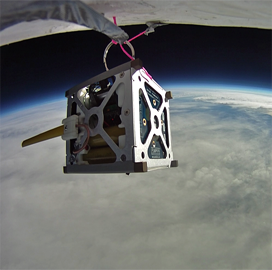 The Johns Hopkins Applied Physics Laboratory and NASAÂ launched two small satellites called cubesats into space in November, The Baltimore Sun reported Jan. 10.
The Johns Hopkins Applied Physics Laboratory and NASAÂ launched two small satellites called cubesats into space in November, The Baltimore Sun reported Jan. 10.
Scott Dance writes the devices are intended for use in earth and space science research and earth radiation studies.
“This has the potential of being disruptive,” Ann Darrin, managing executive of Johns Hopkins APL, told the publication.
The cubesat features solar panels, a global positioning system, data communication systems and technologies for maintaining Earth and space orientation, according to the report.
The Defense Department is using the satellites, enclosed in three 34 by 10 by 10-centimeter units, for communications research, reports the Baltimore Sun.
Dance writes a space mission for atmospheric radiation measurement is scheduled for launch in 2015 using 30 to 40 cubesats.
“If you can put more of them up there, you can get better mapping and better science,” said Gary Crum, NASA Goddard Space Flight Center cubesat systems lead.




